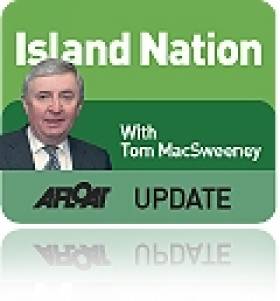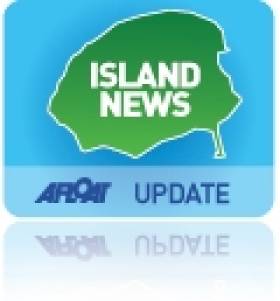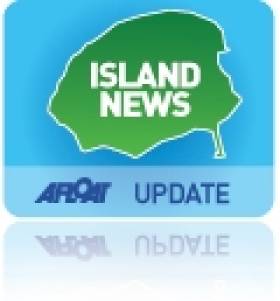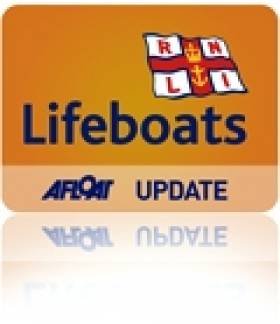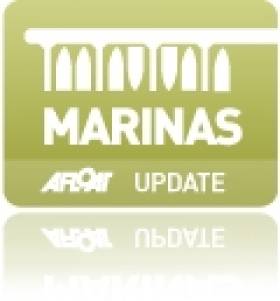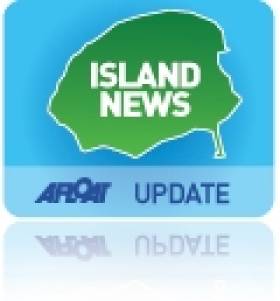Displaying items by tag: Cape Clear
Marine Minister Forecasts Wooden Boat Building Revival
#woodenboat – Marine Minister Simon Coveney is confident that wooden boat building in Ireland is going to be revived writes Tom MacSweeney.
Traditional skills have been lost and there are fears that they will disappear forever, but the Minister sounds a confident note about preserving them on the current edition of my maritime programme, THIS ISLAND NATION.
"This project is going to reinvigorate wooden boat building in Ireland again. It is going to open a new chapter for us," he says. "Hopefully multiple ports around the country will be able to build projects like this in the future. We still have great skill sets of wooden boat building available to us in Ireland which we must not lose. It is projects like this that will keep them alive and encourage a new young generation."
I recorded Mr.Coveney at Liam Hegarty's boatyard at Oldcourt near Skibbereen where the Ilen, the last traditional sailing boat of its kind, is being restored. It is the boat which the legendary Conor O'Brien had built for the Falkland Islanders who so admired his previous vessel, Saoirse, when he sailed it into those islands during his round-the-world voyage in 1923-25. Liam Hegarty's yard at Oldcourt on a bend of the road from Skibbereen to Baltimore in West Cork is one of the few remaining that specialises in wooden boat building.
The Falklanders asked O'Brien, the first Irishman to sail a round-the-world voyage to emulate the boat on which he arrived in Port Stanley. He did as they asked, having the Ilen built in Baltimore, where Saoirse was also constructed. With two Cape Clear Islanders as crew, he sailed it to the Falklands in 1926 where it worked for 70 years until Limerickman, Gary McMahon, had it brought back to Ireland in 1997:
I was the only reporter on the quayside in Dublin when it was landed there from the deck of a cargo ship, looking every bit her age of 71 years at the time. So it was a great feeling to stand on her deck in Liam Hegarty's boatshed where the restoration work has been carried out, in conjunction with the AK Ilen boat building school, initiated by Gary McMahon, the driving force of the project Such a change from the condition in which I had seen her in the Dublin docks 18 years ago.
Gary McMahon, Liam Hegarty and Minister Coveney tell the story on the programme. Gary and Liam are both confident that Ilen will be back in the water, sailing once again. She may provide opportunities for effective sail training. Several sources have provided restoration funding. More is needed for a project which, as the Minister said, can restore Ireland's resource of traditional skills.
Also on the programme you can hear the story of a submarine which sank not once, but twice, which will make you wonder whether superstition about changing the names of boats is correct. And did you know that the Dubs beat the Kingdom ... Not in football, but fishing...?
You can hear more by listening to THIS ISLAND NATION above.
Cape Clear Lock Chamber Delivery & Installation
#capeclear – As Afloat.ie reported earlier this month, L&M Keating Ltd, a building and civil engineering contractor, successfully towed and installed the contractor designed 1000t reinforced concrete lock chamber for a new storm gate on Cape Clear Island, Co. Cork from its casting basin in Verolme Dry Dock in Cork Harbour to the island, a tow of approximately 100 kilometres. L&M Keating Director Richard Browne describes how the work was completed.
Cape Clear is Ireland's most southerly island being 6 miles off Cork's Atlantic Coast in exposed waters just a few miles from the Fastnet Rock Lighthouse. To protect the islands boating fleet during severe storms the Irish Department of Agriculture Food and the Marine have commissioned hydraulically operated storm gates to enable the inner harbour to be rapidly closed off. These gates require a substantial concrete structure to accurately hold and align the gates, in a water depth varying from 4 to 8 meters.
In response to the Departments tender invitation L&M Keating Ltd. offered a novel solution involving the precasting of the lock in a dry dock in Cork Harbour and installing temporary steel stop logs to form an enclosed chamber that would float. This chamber was then towed to site and sank on to a prepared concrete base.
After a week of pre tow preparation in the dry dock involving the installation of a deck, emergency pumping arrangements, ballasting, fitting of navigation marks and sea fastening works the sea structure was towed to sea the morning of Saturday 27th September.
The chamber was towed by the 4,000hp tug "Celtic Isle" provided by the Mainport Group, and was accompanied out of Cork Harbour by the Port Authorities tug "Gerry O'Sullivan".
Once at sea the chamber was towed at an average speed of 3.5knts arriving at Cape Clear in the early hours of Sunday 29th. The tow was then transferred to the smaller vessels "Barracuda" Vincent O'Driscoll's tug boat and Diarmuid O'Donovan's boat "Souris", and was brought into its final position against temporary steel guides. As the tide dropped the chamber followed the guides down until it rested on a concrete bed prepared earlier by divers. Once on the bottom, the chamber was flooded to prevent it floating off again.
The works are part of a €4.3M development which includes a 70m slipway, automated hydraulic storm gates (12x8m) and reconfiguration of the existing harbour entrance.
Work now continues to tie the quay on each side of structure in to the chamber, seal anchor the chamber with grout and to install and the electrical and hydraulic system commences.
Cape Clear Harbour Works Continue With New Slip & Pier Works
#capeclear – Construction work continues apace at Cape Clear island in West Cork as this latest photo posted via Twitter reveals. As Afloat previously reported in March, the works have involved the construction of a slipway; replacement of the Bull's Nose structure incorporating a storm gate and an extension to the end of Duffy's Pier; excavation, dredging and reclamation works including the construction of an armoured embankment at the seaward side of the new Bull's Nose structure.
A short aerial video of the installation of the massive 950–tonne precast concrete storm gate chamber is below. Scroll down to view.
#capeclear – Construction works are scheduled to commence at North Harbour, Cape Clear Island, Co. Cork. The works will take place at the mouth of the harbour (Co-ordinates 51° 26.5' North, 009° 30.22' West).
The works will involve the construction of a slipway; replacement of the Bull's Nose structure incorporating a storm gate and an extension to the end of Duffy's Pier; excavation, dredging and reclamation works including the construction of an armoured embankment at the seaward side of the new Bull's Nose structure.
For safety reasons, mariners are requested to proceed slowly and with caution in the approach to the entrance to North Harbour and to give the works a wide berth. Wave-wash from vessels should be avoided. Divers will be deployed throughout the underwater works.
North Harbour will remain operational throughout the works, which are expected to be on- going until the end of 2014.
For further information, contact the Marine Engineering Division (Department of Agriculture, Food & the Marine) Tel: + 353 (0)66 7149340.
Marine Minister Welcomes Signing Of Contractor For Cape Clear Harbour Works
#IrishHarbours - Marine Minister Simon Coveney today (13 December) attended the signing of a contract with L&M Keating Ltd for the remediation and harbour improvement works at North Harbour on Cape Clear, Co Cork.
Welcoming the commencement of the project, and referring to the benefits of this significant investment, the minister said: “This initiative will provide much needed infrastructural improvement and will provide employment during and after the construction phase giving an opportunity to develop the island’s economic potential as well as boosting quality of life on the island.”
The minister has responsibility for North Harbour on Cape Clear which, as the safest landing location on the West Cork island, is of infrastructural importance to the island population.
The pier known as 'Bull Nose' has been deteriorating in recent years and has been the cause of some concern. This major project will stabilise and upgrade the pier and provide a storm gate between the two harbour piers.
The minister said that the development "is part of a wider Government strategy for capital investment in various harbours throughout the country in 2014”.
He added: “I view this project as a testament to this Government's support of island communities and will be paying particular attention to its progress during the course of 2014.”
The works will be carried out by an Irish company L&M Keating Ltd, Building & Civil Engineering Contractors, Kilmihil, Co Clare.
The project will significantly improve shelter within the outer basin of the North Harbour and will cost in the region of €4 million, which will be funded through the Department of Agriculture, Food and Marine's Coastal Infrastructure Development Programme. It is due to be completed by the end of 2014.
Baltimore RNLI Lifeboat Bring 15–Year–Old Islander to Mainland for Medical Attention
#rnli – Baltimore all weather lifeboat in West Cork was launched to carry out a medical evacuation from Cape Clear Island in West Cork last night. The call for assistance was made at 10:04pm on Monday 23rd Sept when a 15 year old youth required urgent medical attention.
The all weather lifeboat Alan Massey was launched within minutes under the command of Coxswain Kieran Cotter proceeding to North Harbour on Cape Clear Island in fresh weather conditions. The lifeboat collected the youth and in less than one hour had brought him to Baltimore to deliver him into the care of the ambulance service.
Coxswain Kieran Cotter remarked that 'given its speed and sea worthiness, the lifeboat is ideal for use in these emergencies'.
Next Sunday 29th Sept the crew of lifeboat are inviting the public to the station open day between 2:30pm and 5:30pm. The new state of the art building will be open to public view, as will the Atlantic 75 RIB inshore lifeboat and the Tamar class all weather lifeboat. All welcome - free of charge.
On board were Coxswain Kieran Cotter, Mechanic Cathal Cottrell, Jerry Smith, Pat Collins, Tadhg Collins, John Rochford and John O'Flynn.
New Research Says Sonar Sends Whales Scurrying
#MarineWildlife - The Guardian reports on new research which proves that military sonar has a direct effect on the behaviour of whales in our oceans - even leading to mass strandings.
The studies, part funded by the US Navy, found that beaked whales where particularly sensitive to sonar - and that even blue whales, the largest animals on earth, were distracted from feeding by the subsurface noise.
It's long been feared that the use of sonar is to blame for unusual behaviour among whales, who navigate and communicate with each other over long distances using sound.
As previously reported on Afloat.ie, the Irish Whale and Dolphin Group (IWDG) identified sonar activity by Royal Navy submarines as a possible cause of a the mass stranding of pilot whales in Donegal in November 2010, in which as many as 35 whales died.
Now for the first time, sonar has been proven to affect behaviour of cetaceans to a detrimental degree, confirming for many a connection between the use of sonar technology and recordings of whale and dolphin strandings identified since the 1950s. The Guardian has much more on the story HERE.
In more positive whale-related news, the IWDG reports that its next Cape Clear summer whalewatching course over the weekend of 26-28 July is "filling up nicely".
Places are still available but as it coincides with the tourism high season in West Cork, anyone interested is advised to book sooner than later to ensure they have someone to stay nearby.
The most recent weekend course over the June bank holiday witnessed numerous harbour porpoises and common dolphins, but its hoped the elusive whales will make an appearance next time round!
The West Cork Islands of Bere, Dursey, Garnish, Heir, Long, Cape Clear, Sherkin and Whiddy are inviting visitors to 'explore the islands, experience island life' in a special island festival in June.
The idea behind the celebration from June 15 and 16 is to encourage visitors to see what life on an island is like. The island communities are saying 'be an islander for the weekend'. Enjoy reduced rates on ferries/cable car activities, services and accommodation. Jump on a ferry or the cable car at islander rates.
More details on the festival are here
Surface Search for Missing Diver Winds Down
#MISSING DIVER - Teams were still searching yesterday at a wreck site off Cape Clear for a diver missing since Tuesday, according to The Irish Times.
A Defence Forces spokesperson told the paper that a sonar device would be employed to scan the seabed for any sign of 54-year-old Reinhardt Teschke, who failed to resurface from a 90m dive on the wreck of British merchant vessel the Minnehaha.
As previously reported on Afloat.ie, Baltimore RNLI launched both its inshore and all-weather lifeboats to the scene south of Balitmore Harbour in West Cork on Tuesday evening to search for the German diver, one of a party of three at the wreck site.
Irish Coast Guard helicopter Rescue 115 and the Naval Service vessel LE Ciara were also involved in the surface search, which was set to be wound down yesterday.



























